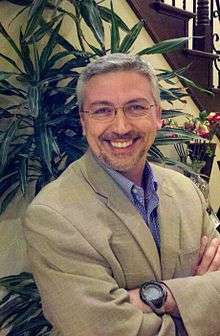Massimiliano Di Ventra
| Massimiliano Di Ventra | |
|---|---|
 | |
| Residence | USA |
| Nationality | American-Italian |
| Fields | Physics, Nanotechnology |
| Institutions | UCSD |
| Alma mater | EPFL |
| Known for |
Transport in nanoscale systems |
Massimiliano Di Ventra is an American Italian theoretical physicist who has made several contributions to Condensed-Matter Physics, especially transport properties of nanoscale systems,[1] non-equilibrium statistical mechanics of many-body systems,[2] DNA sequencing by tunneling,[3] memristors, memcapacitors, and meminductors.[4]
He obtained his undergraduate degree in Physics summa cum laude from the University of Trieste (Italy) in 1991 and did his PhD studies at the École Polytechnique Fédérale de Lausanne (Switzerland) in 1993–1997, after one year of mandatory military service. He has been Visiting Scientist at IBM T.J. Watson Research Center and Research Assistant Professor at Vanderbilt University before joining the Physics Department of Virginia Tech in 2000 as Assistant Professor. He was promoted to Associate Professor in 2003 and moved to the Physics Department of the University of California, San Diego, in 2004 where he was promoted to Full Professor in 2006.
Di Ventra's research interests are in the theory of electronic and transport properties of nanoscale systems, non-equilibrium statistical mechanics, DNA sequencing/polymer dynamics in nanopores, and memory effects in nanostructures for applications in unconventional computing and biophysics.
He has been invited to deliver more than 230 talks worldwide on these topics (including 7 plenary/keynote presentations, 7 talks at the March Meeting of the American Physical Society, 5 at the Materials Research Society, 2 at the American Chemical Society, and 1 at the SPIE). He serves on the editorial board of several scientific journals and has won numerous awards and honors, such as the NSF Early CAREER Award, and the Ralph E. Powe Junior Faculty Enhancement Award. He is fellow of the Institute of Physics and the American Physical Society. He has published more than 170 papers in refereed journals (13 of these are listed as ISI Essential Science Indicators highly cited papers of the period 2003–2013), co-edited the textbook Introduction to Nanoscale Science and Technology (Springer-Verlag, 2004) [5] for undergraduate students, and he is single author of the graduate-level textbook Electrical Transport in Nanoscale Systems (Cambridge University Press, 2008).[6]
References
- ↑ Electrical Transport in Nanoscale Systems (Cambridge University Press, 2008)
- ↑ Stochastic Time-Dependent Current-DFT
- ↑ Fast DNA sequencing via transverse electronic transport
- ↑ Circuit elements with memory: memristors, memcapacitors, and meminductors
- ↑ Introduction to Nanoscale Science and Technology (Springer-Verlag, 2004)
- ↑